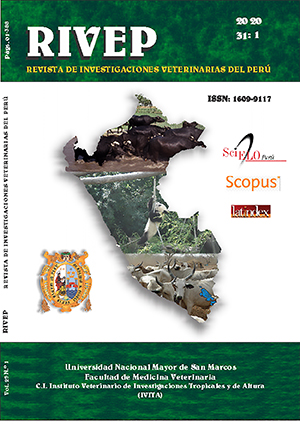Sanitary characterization and identification of microbial contamination points in the fishing marketing chain in the port of Pucallpa, Ucayali, Peru
DOI:
https://doi.org/10.15381/rivep.v31i1.17539Keywords:
sanitary characterization, fishing commercialization, ports, UcayaliAbstract
The aim of this study was to conduct the sanitary characterization of the fishing marketing chain and identify the points of microbiological contamination from landing to sale, in the port of Pucallpa, Ucayali, Peru. Artisanal fishing ends with the landing of wooden boats with motor. The fish are washed in the river water, as well as plastic material and tubs within 150 m of the riverbank. The fish are transferred covered with crushed ice, plastic layers and rice husk. The facilities for sale are made of wood. There are no programs to disinfect or sanitize the area and solid waste is disposed of in a nearby sector. Work clothing is not used by fishermen, but some primary marketers use it. The physicochemical parameters of the water samples were within the normal ranges, but the presence of coliforms, E. coli and Pseudomona sp at high levels was detected. In fish, mesophiles were above the Maximum Permissible Limit (MPL) in catfish meat (Siluriforme spp); E. coli was at low levels in the meat of the three species evaluated (black prochilodus [Prochilodus nigricans], silver mylossoma [Mylossoma duriventre] and catfish); Staphylococcus aureus was present at low levels, but above the MPL in catfish, and Salmonella sp, Vibrio cholerae and V. parahemolyticus were absent. In facilities, furniture and hands of the fihermen was found E. coli and high counts of coliforms. The results show an artisanal management with poor biosecurity in the fishing marketing chain and a moderate microbiological contamination, both in facilities, in fishermen and in fish.
Downloads
Downloads
Published
Issue
Section
License
Copyright (c) 2020 Juan Rondón E., Daphne Ramos D., Miguel Vilca L., Rosa González V., Eduardo Salazar S., Yamili Mendoza Q.

This work is licensed under a Creative Commons Attribution-NonCommercial-ShareAlike 4.0 International License.
AUTHORS RETAIN THEIR RIGHTS:
a. Authors retain their trade mark rights and patent, and also on any process or procedure described in the article.
b. Authors retain their right to share, copy, distribute, perform and publicly communicate their article (eg, to place their article in an institutional repository or publish it in a book), with an acknowledgment of its initial publication in the Revista de Investigaciones Veterinarias del Perú (RIVEP).
c. Authors retain theirs right to make a subsequent publication of their work, to use the article or any part thereof (eg a compilation of his papers, lecture notes, thesis, or a book), always indicating the source of publication (the originator of the work, journal, volume, number and date).



